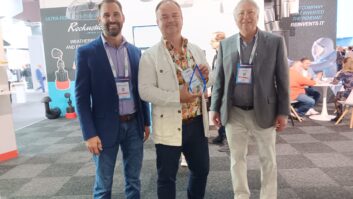WHITE PLAINS, N.Y. — Sept. 8, 2017 —
SMPTE(R), the organization whose standards work has supported a century of advances in entertainment technology, today announced the program for the
SMPTE 2017 Symposium: “Artificial Intelligence (AI) and Machine Learning in Digital Media Creation: The Promise, The Reality, and The (Scary?) Future.”
The Oct. 23 event, which will take place at the Hollywood & Highland Center in Hollywood, California, immediately precedes the SMPTE 2017 Annual Technical Conference & Exhibition (SMPTE 2017).
“We’re incredibly proud of the amazing speakers we have lined up for this year’s event,” said SMPTE Education Vice President Richard Welsh, CEO of Sundog Media Toolkit. “The breadth and depth of their expertise will give Symposium attendees a compelling perspective on the brave new world of AI and machine learning.”
Co-chaired by SMPTE Fellow Michelle Munson, co-founder of Aspera, and Yvonne Thomas, product manager at Arvato Systems, the SMPTE 2017 Symposium will examine how AI and machine learning (ML) technologies have gained significant traction in the creation of digital media. Subject matter experts, visionaries, and thought leaders in the field will assist attendees in establishing a firm foundation for understanding these technologies, which may eventually disrupt the media and entertainment industry.
Munson and Thomas will open the program at 9 a.m. along with Welsh and SMPTE President Matthew Goldman, senior vice president of technology, TV compression, at Ericsson. Next, Welsh will present
“Understanding AI, Analytics, and Machine Learning,”
a tutorial demonstrating these technologies as beyond algorithms and rather as critical elements in the ML network for reproducing results.
Jeff Kember, technical director for media in the office of the CTO at Google, will deliver the keynote address at 9:45 a.m. He will discuss the latest opportunities and advances in ML, and how AI and ML are shaping the future of the media and entertainment industry.
Kember’s keynote address will be followed by the session
“How Digital Transformation Is Changing Media & Entertainment With Machine Learning, Content & Data Intelligence and Heterogeneous Integrated Workflows,”
presented by Jay Yogeshwar, director, media and entertainment at Hitachi Data Systems. Yogeshwar will describe the challenges the media and entertainment industry is facing in adapting data integration and intelligence methods to enable automated workflows, with the goal of a successful digital transformation of content creation and delivery.
Next up, in her session
“Predicting the Future With Media Analytics Services,”
Symposium Co-chair Thomas will describe how media intelligence based on big data analytics can increase efficiency in journalistic workflows and assist operations in monetizing content more efficiently. Key takeaways for attendees will include how to enrich metadata and guide production decisions; how to ensure the reliability of AI-generated data and nurture the learning machines; and how to visualize and present large amounts of data in a way that makes workflows more efficient.
The morning program will wrap with
“Machine Translation of Timed Text: My Machine Can Read Faster Than Me,”
presented by Chris Reynolds, vice president, global partnerships, technology and innovation, Deluxe Entertainment Services Group; and Greg Taieb, senior director, Sfera at Deluxe Entertainment Services Group. Reynolds and Taieb will present examples and case studies that demonstrate the limits of current machine translation technology while also examining how ML may be implemented to improve the quality of translations continually. Additionally, they will explore how the current state of machine translation can be leveraged through cloud-based web applications to aid human translators and bring higher levels of quality and efficiency to video localization workflows.
Following a networking lunch, the Symposium will reconvene with a two-part tutorial focused on ML and presented by SMPTE Fellow and Symposium Co-chair Munson. In part one,
“Machine Learning Foundations (Theory and Practice),”
Munson will offer a foundation for digital media engineers in the theoretical underpinnings of ML programs: what they are, an introduction to classes of both supervised and unsupervised learning algorithms, and examples of these techniques in practice covered by leading over-the-top (OTT) and media content distribution technologists. In part two,
“Using Machine Learning to Predict Optimal Sources for Content in a Heterogeneous Network,”
Munson will outline a new ML algorithm and implementation that applies continuous multivariable regression to help predict the best (most optimal) source of content in a distributed and heterogeneous storage network.
In the next session,
“Microsoft’s New Video Analytics Platform — A Scalable Turnkey Cloud Service for Understanding What’s in Your Media,”
Martin Wahl, principal program manager for Microsoft’s Azure Media Services, will take the audience through the capabilities of the company’s robust new AI-based video indexing service and give a view into its underlying machine learning models and cognitive services.
Konstantin Wilms, principal solutions architect at Amazon Web Services, will follow up with
“Content Intelligence on AWS — Integrating Artificial Intelligence and Machine Learning Technologies Into Cloud-based Media Workflows.”
Here, Wilms will take a deep dive into AI and ML in the cloud, illustrating how these technologies and services can best be used to enhance both new and existing content workflows.
The SMPTE 2017 Symposium will conclude with a panel discussion,
“The Power of AI — How AI Can Change Our Business.”
Panelists will discuss AI’s growing role in the industry, driven by the power of owning big data together with the ability to process and understand the data. The panel will present new perspectives on the AI-enabled media business, including how to monetize data and the challenges facing humans in “reigning over machines.”
The Symposium is a favorite element of the SMPTE Annual Technical Conference & Exhibition, the world’s premier forum for the exploration of media and entertainment technology. Symposium registration is included with select SMPTE 2017 conference packages, as an add-on, or as a stand-alone registration. Further details about the Symposium are available at
http://www.smpte2017.org/ai-ml-symposium.html
.
Other events taking place on Monday, Oct. 23 include the annual
Women in Technology Luncheon
, presented by SMPTE and Hollywood Professional Association (HPA) Women in Post, and the
SMPTE-HPA Student Film Festival
, which will highlight the creative use of technology to support the art and craft of storytelling. Tickets for these events are required and may be purchased with conference registration or as a standalone, ticket-only registration.
From Tuesday, Oct. 24, through Thursday, Oct. 26, SMPTE 2017 will fill two exhibit halls and multiple session rooms at the Hollywood & Highland Center. The event will also feature an Oktoberfest reception, Broadcast Beat’s SMPTE 2017 Live! Studio, and special events culminating with the
SMPTE Annual Awards Gala
at the Loews Hollywood Hotel’s Hollywood Ballroom on the evening of Oct. 26.
Complete information about SMPTE 2017 is available at
. More information about SMPTE and its standards work is available at
.
# # #
About SMPTE(R)
For more than a century, the people of SMPTE (pronounced “simp-tee”) have sorted out the details of many significant advances in media and entertainment technology, from the introduction of “talkies” and color television to HD and UHD (4K, 8K) TV. Since its founding in 1916, SMPTE has received an Oscar(R) and multiple Emmy(R) Awards for its work in advancing moving-imagery engineering across the industry. SMPTE has developed thousands of standards, recommended practices, and engineering guidelines, more than 800 of which are currently in force today. SMPTE Time Code(TM) and the ubiquitous SMPTE Color Bars(TM) are just two examples of SMPTE’s notable work. As it enters its second century, SMPTE is shaping the next generation of standards and providing education for the industry to ensure interoperability as the industry evolves further into IT- and IP-based workflows.
SMPTE’s global membership today includes more than 7,000 members: motion-imaging executives, creatives, technologists, researchers, and students who volunteer their time and expertise to SMPTE’s standards development and educational initiatives. A partnership with the Hollywood Professional Association (HPA) connects SMPTE and its membership with the businesses and individuals who support the creation and finishing of media content. Information on joining SMPTE is available at
.
All trademarks appearing herein are the properties of their respective owners.
PR Link:
www.wallstcom.com/SMPTE/170908SMPTE.docx
Photo Link:
www.wallstcom.com/SMPTE/SMPTE_Jeff-Kember.jpeg
Photo Caption:
Jeff Kember, SMPTE 2017 Symposium Keynote Speaker
Photo Link:
www.wallstcom.com/SMPTE/SMPTE_Michelle-Munson.jpeg
Photo Caption:
Michelle Munson, SMPTE Fellow and 2017 Symposium Co-chair
Photo Link:
www.wallstcom.com/SMPTE/SMPTE_Yvonne-Thomas.jpeg
Photo Caption:
Yvonne Thomas, SMPTE 2017 Symposium Co-chair
Share it on Twitter:










